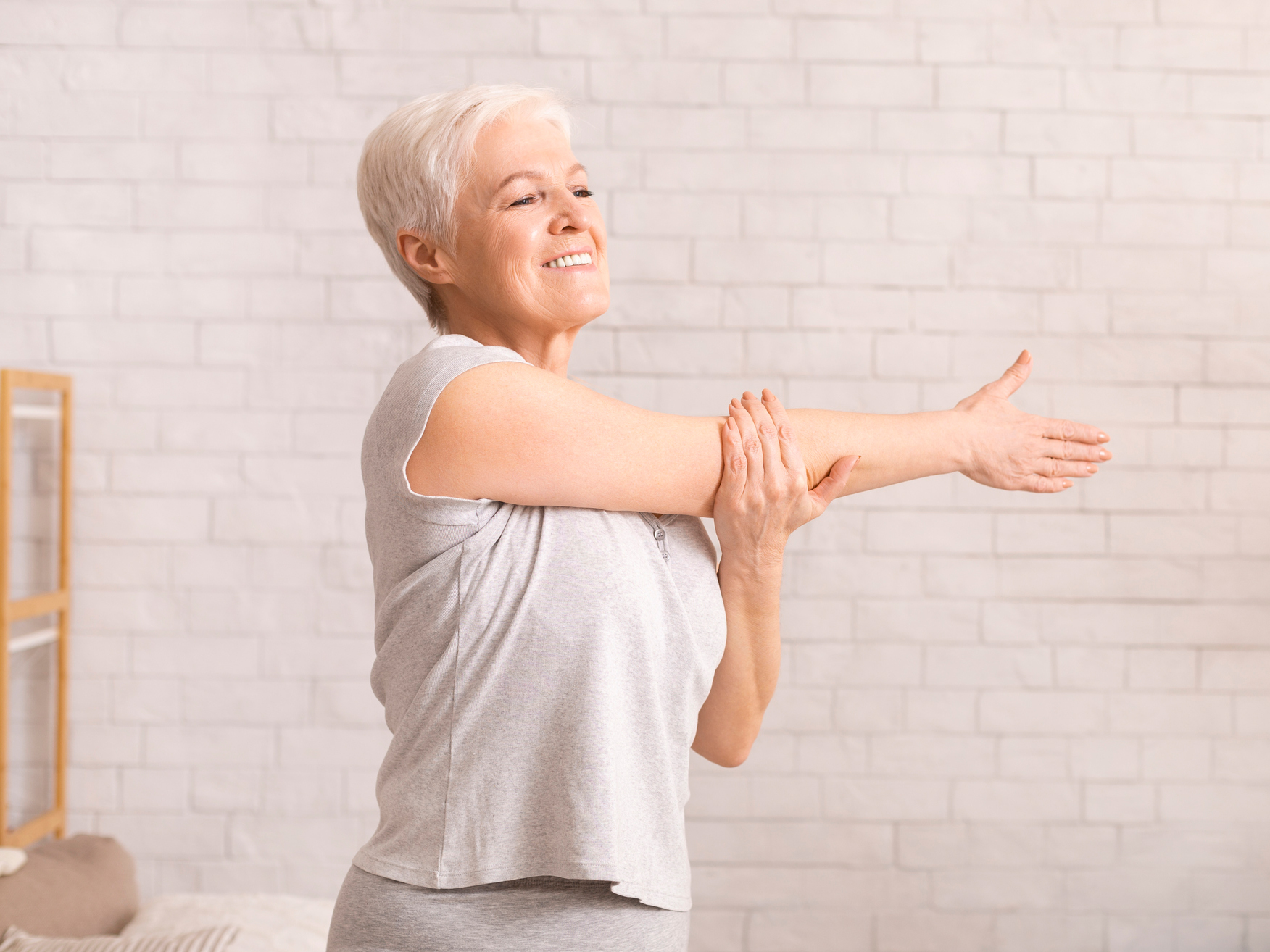Get Easy Health Digest™ in your inbox and don’t miss a thing when you subscribe today. Plus, get the free bonus report, Mother Nature’s Tips, Tricks and Remedies for Cholesterol, Blood Pressure & Blood Sugar as my way of saying welcome to the community!
The ‘extra’ benefits of an at-home fitness routine during social distancing

As the COVID-19 pandemic runs its course, we’re being advised to stay at home as much as we can.
But this shouldn’t mean that we let our physical fitness fall by the wayside. In fact, now more than ever, it’s important to find some simple, do-able ways to keep moving.
Right now, the mental and emotional benefits of exercise are just as important as the physical benefits, if not more important.
Exercise “decreases stress and anxiety,” says Becky Hill, who is also a fitness trainer and therapist. Everyone is stressed at the moment and people aren’t sleeping, she says. “But if you’re moving, you’re likely to sleep better.”
We’re lucky that spring is upon us, and getting outside, either alone or while keeping a good distance between people, is definitely still an option. Breathing fresh air during the day helps most people sleep more soundly.
We’ve long known that exercise relieves anxiety, boosts cognitive function, and grants us more energy.
It’s even been shown that the calming effects of exercising have a longer “shelf life” than we’d thought. When anxiety rears its head after an exercise session, those calming effects can still be felt.
Here, then, is a quick guide to exercising during this less-active, stay-at-home time, including how much exercise is right for you, and some creative ways to keep those muscles moving without heading to the gym.
How much is too much?
Like at any other time, it’s best not to overdo it on exercise, and to respect the needs of your body. Now in particular, though, this is really important.
Dr. Tamara Hew-Butler and Dr. Mariane Fahlman both teach at Wayne State University in Indiana. Dr. Hew-Butler is a podiatric physician, and Dr. Fahlman is a researcher who focuses on the relationship between exercise and the immune response, functional capacity, and cognition.
Both these doctors agree that, for most people, 20 to 45 minutes of mild to moderate exercise, up to three times a week, is the “just right” amount.
They advise that, during this quarantine or social distancing period, your goal should be to maintain strength and fitness, rather than to increase it.


Exerpeutic Folding Magnetic Upright Exercise Bike with Pulse
Can be folded up and rolled away when you are finished exercising. Designed to support up to 300 lbs. Features like the “high torque” 3 piece crank system, magnetic resistance, heart pulse monitoring and a “double drive” transmission system are all included for a very affordable price.
And there are some things you shouldn’t do:
- Don’t exercise past the point of exhaustion. It increases the chance of infection. For example, now would not be the time to take up marathon running. After a marathon race, the risk of illness jumps from 2.2 percent to 13 percent!
- Do not exercise if you have any flu symptoms. Use your energy to recover your health first.
- Don’t exercise more than five days per week.
- Don’t overdrink fluids, especially when you’re sick. Many people think you can “flush out” toxins with tons of water. This is not true.
Fitness indoors: It doesn’t have to make you sweat
If you’re in your 50s or above, the aim of your indoor exercise program should be strength, flexibility, and balance. It’s vital to maintain these, to prevent falls that can result in debilitating injuries, such as a broken hip or leg.
The British National Health Service offers a guide to seven simple exercises to improve strength and flexibility, all of which are done while sitting.
Yoga and tai chi done at home with a video program or with a partner (while keeping a safe distance) are also good choices for maintaining balance and strength during this time.
Here are a few exercises you can try at home, no equipment needed:
- Chair tricep dips– Sit on the edge of a chair holding onto the front with your hands. Place your feet out in front of you (bent legs for easier option or straight legs to make it harder) and lower your elbows to a 90-degree angle before pushing back up.
- Tabletop press-ups– Incline press-ups can be done anywhere around the home – on a table, a bed, a chair or even a wall. To use a table, place your hands on the table with your legs stretched out behind you, body nice and straight. Lower your weight down keeping your elbows tight to your body, and press back up.
- Living room wall sits– find a wall with a big enough space for you to lean on. Sit against the wall like you would in a chair with your legs at 90 degrees, and hold. Give it time and you’ll soon feel the burn!
- Milk bottle Russian twists– Sit on the floor holding a milk bottle (or any bottle with liquid in). Lean back with a straight back and engage your core. Rotate your torso and try to touch the floor on each side with the milk bottle. Make it harder by lifting your feet off the floor.
And finally, hip2save.com is a site where you can find all sorts of ways to work out at home, from free YouTube fitness channels to free workout apps you can download.
Sources:
- Coronavirus: How to exercise while staying at home — BBC News
- Should I exercise during the coronavirus pandemic? Experts explain the just right exercise curve — The Conversation
- Effects of emotional exposure on state anxiety after acute exercise — Medicine & Science in Sports & Exercise
- Is Exercise Protective Against Influenza-Associated Mortality? — PLOS ONE













